85 Male and female reproductive systems
Learning Objectives
After reading this section you should be able to-
- Compare and contrast the major anatomy of the male and female reproductive systems.
- Identify male and female homologues of various reproductive system structures (e.g., ovary is homologous to the testis).
- Describe the functions of the hormones involved in the regulation of the reproductive processes (e.g., gonadotropin releasing hormone [GnRH], follicle stimulating hormone [FSH], luteinizing hormone [LH], androgens, inhibin, estrogens, progesterone).
The Female Reproductive System
Vulva
The mons pubis, labia majora, labia minora, and vestibule are collectively referred to as the vulva. The mons pubis is a pad of fat that is located over the pubic bone. After puberty, it becomes covered in pubic hair. The labia majora (labia = “lips”; majora = “larger”) are folds of pubic hair-covered skin that extend from the mons pubis to the perineal raphe – the region of skin between the vaginal opening and the anus. The thinner and more pigmented labia minora (labia = “lips”; minora = “smaller”) are medial to the labia majora. The labia majora and minora naturally vary in shape and size from person to person, and left-right asymmetries are normal and expected. The vestibule is the region between the two labia minora. The labia minora protect the mucous membranes and orifices of the urethra and vagina, found in the vestibule.
Clitoris
The superior, anterior portions of the labia minora come together to meet the glans of the clitoris which has an extremely dense network of nerve endings. This glans portion of the clitoris is partially covered by the prepuce (foreskin). The clitoris also includes crura, or legs (sing.: crus or leg), which are subcutaneous and extend inferiorly, following the contours of the pubic rami. The body of the clitoris connects the glans and crura. The glans, crura and body are made up of corpus cavernosum erectile tissue.
In contrast, the bulbs of the vestibule are made up of corpus spongiosum erectile tissue. The vestibule is found medial to the crura of the clitoris and surrounds the vaginal and urethral orifices. The non-erect clitoris (including the superficial glans through to the end of the subcutaneous crura) has been recorded to be as long as 9 cm.
The Female Prostate
Surrounding the urethra is glandular tissue that has been called the periurethral gland, the paraurethral gland, the lesser vestibular gland and the female prostate. These glands were first identified in the 1600’s, and appeared again in the anatomical literature of the 1800’s. In 2002, the Federative International Programme for Anatomical Terminology committee officially voted to use the term “female prostate” to describe these glands that surround the urethra. Collectively, they release the fluids of female ejaculation. As with all anatomy, there is a degree of variation in regard to the size, number and location of the ducts leading from the female prostate, but the ducts typically lead to the distal portion of the urethra.
Greater Vestibular Glands
The paired greater vestibular glands (Bartholin’s glands) are located inferior and posterior to the bulbs of the vestibule. The glands secrete mucous into the vestibular area through ducts which open on either side of the vaginal orifice.
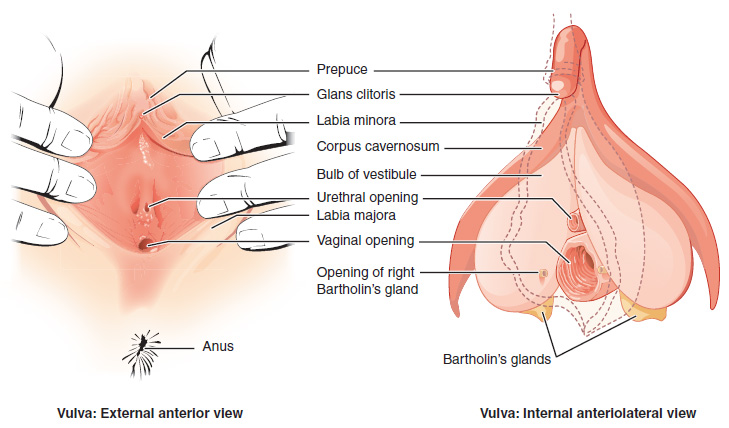
Vagina
The vagina (Figure 84.1) is a muscular canal (approximately 10 cm long) typically leading to the uterus. The superior portion of the vagina—called the fornix—meets the protruding uterine cervix. The walls of the vagina are lined with an outer fibrous adventitia; a middle layer of smooth muscle; and an inner mucous membrane with transverse folds called rugae. Together, the middle and inner layers allow the expansion of the vagina. The vaginal opening is located between the opening of the urethra and the anus. The hymen is a thin membrane that sometimes partially covers the entrance to the vagina. An intact hymen cannot be used as an indication of “virginity”; even at birth, this is only a partial membrane, as menstrual fluid and other secretions must be able to exit the body. The opening between the hymen and the vaginal wall can change in size based on the degree to which the hymen is stretched. The membrane will decrease in size due to increased pressure.
The vagina is home to a normal population of microorganisms that help to protect against infection by pathogenic bacteria, yeast, or other organisms that can enter the vagina. In a healthy vagina, the most predominant type of bacteria is from the genus Lactobacillus. This family of beneficial bacterial flora secretes lactic acid, and thus protects the vagina by maintaining an acidic pH (below 4.5). Potential pathogens are less likely to survive in these acidic conditions. Lactic acid, in combination with other vaginal secretions, makes the vagina a self-cleansing organ. Douching (washing out the vagina with fluid) disrupts the normal balance of healthy microorganisms, and increases the risk for infections and irritation. The American College of Obstetricians and Gynecologists recommends against douching, and instead recommends allowing the vagina to maintain its normal healthy population of protective microbial flora.
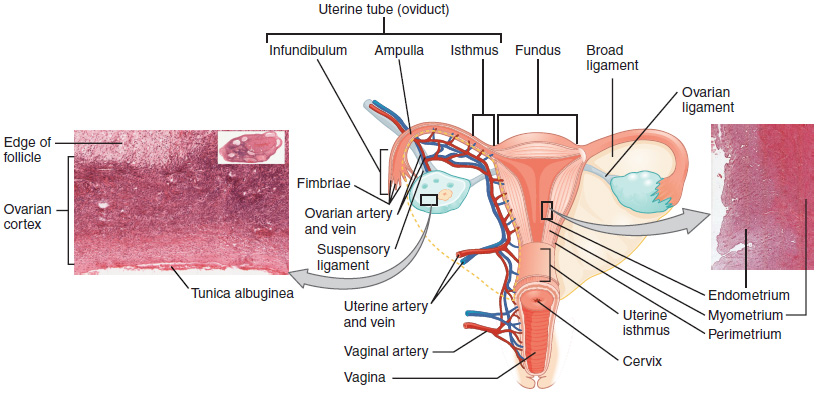
Uterus
The uterus is a muscular organ with an average size 5 cm wide by 7 cm long. It has three regions. The portion of the uterus superior to the opening of the uterine tubes is called the fundus. The middle section of the uterus is called the body. The cervix is the narrow inferior portion of the uterus that projects into the vagina. The cervix produces mucosal secretions that vary in consistency and volume across the ovarian cycle. The cervix opens into the vaginal cavity via the os, which allows the fluid to move through the vagina and exit the body through the vaginal opening.
Several ligaments maintain the position of the uterus within the abdominopelvic cavity. The broad ligament is a fold of peritoneum extending laterally from both sides of the uterus and attaching it to the pelvic wall. The round ligament attaches to the uterus near the uterine tubes, and extends to the labia majora. Finally, the uterosacral ligament stabilizes the uterus posteriorly by its connection from the cervix to the pelvic wall.
The wall of the uterus is made up of three layers. The most superficial layer is the serous membrane, or perimetrium, which consists of epithelial tissue that covers the exterior portion of the uterus. The middle layer, or myometrium, is a thick layer of smooth muscle responsible for uterine contractions. Most of the uterus is myometrial tissue, and the muscle fibers run horizontally, vertically, and diagonally, allowing the contractions that occur during orgasm labor or menstruation. The innermost layer of the uterus is called the endometrium. The endometrium consists of two layers: the stratum basalis and the stratum functionalis (the basal and functional layers).
The uterine tubes (also called Fallopian tubes) serve as the conduit of the oocyte from the ovary to the uterus. The uterine tubes are divided into multiple regions. The isthmus is the narrow medial end of each uterine tube that is connected to the uterus. The middle region of the tube is called the ampulla. The wide distal infundibulum flares out with slender, finger-like projections called fimbriae. The uterine tubes also have three layers: an outer serosa, a middle smooth muscle layer, and an inner mucosal layer. In addition to its mucus-secreting cells, the inner mucosa contains ciliated cells that beat in the direction of the uterus, producing a current that will be critical to move the oocyte.
The open-ended structure of the uterine tubes can have significant health consequences if bacteria or other contagions enter through the vagina and move through the uterus, into the tubes, and then into the pelvic cavity. If this is left unchecked, a bacterial infection (sepsis) could quickly become life-threatening. The spread of an infection in this manner is of special concern when unskilled practitioners perform abortions in non-sterile conditions. Sepsis is also associated with sexually transmitted bacterial infections, especially gonorrhea and chlamydia. These increase the risk for pelvic inflammatory disease (PID), infection of the uterine tubes or other reproductive organs. Even when resolved, PID can leave scar tissue in the tubes, leading to infertility.
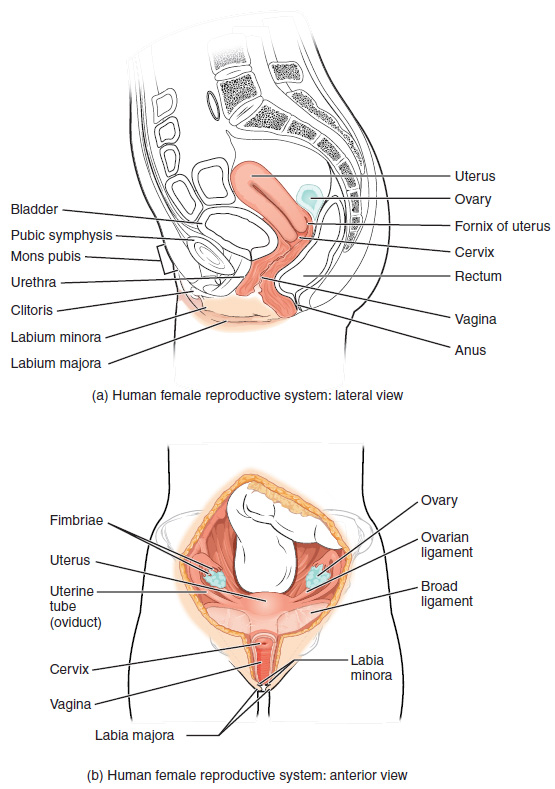
Ovaries
The ovaries are the female gonads (Figure 84.3), located at the distal end of the uterine tubes, close to the fimbriae. They are each about 2 to 3 cm in length, about the size of an almond. The ovaries are responsible for producing the ova (the female gamete), and for producing and secreting female sex hormones. They are supported by the mesovarium, a double fold of peritoneum that is part of the broad ligament. The suspensory ligament is the peritoneum that contains the ovarian blood and lymph vessels. The ovary itself is attached to the uterus via the ovarian ligament.
The ovary comprises an outer covering of cuboidal epithelium that is superficial to a dense connective tissue covering called the tunica albuginea. Beneath the tunica albuginea is the cortex, or outer portion, of the organ. The cortex is composed of a tissue framework called the ovarian stroma that forms the bulk of the adult ovary.
Breasts
The external features of the breast include a nipple surrounded by a pigmented areola (Figure 84.4), whose coloration may deepen due to changes in hormone levels. The areola is typically circular and can vary in size from 25 to 100 mm in diameter. The areolar region is characterized by small, raised areolar glands that secrete lubricating fluid under certain hormonal conditions.
Breast milk is produced by the mammary glands, which are modified sweat glands. The milk itself exits the breast through the nipple via 15 to 20 lactiferous ducts that open on the surface of the nipple. These lactiferous ducts each extend to a lactiferous sinus that connects to a glandular lobe within the breast itself that contains groups of milk-secreting cells in clusters called alveoli (see Figure 84.4). The clusters can change in size depending on the amount of milk in the alveolar lumen. Once milk is made in the alveoli, stimulated myoepithelial cells that surround the alveoli contract to push the milk to the lactiferous sinuses. From here, milk can be drawn through the lactiferous ducts by suckling. The lobes themselves are surrounded by fat tissue, which determines the size of the breast; breast size differs between individuals and does not affect the amount of milk produced. Asymmetry in breast size within an individual is expected and normal. Increased levels of hormones can lead to further development of the mammary tissue and enlargement of the breasts. Supporting the breasts are multiple bands of connective tissue called suspensory ligaments that connect the breast tissue to the dermis of the overlying skin.
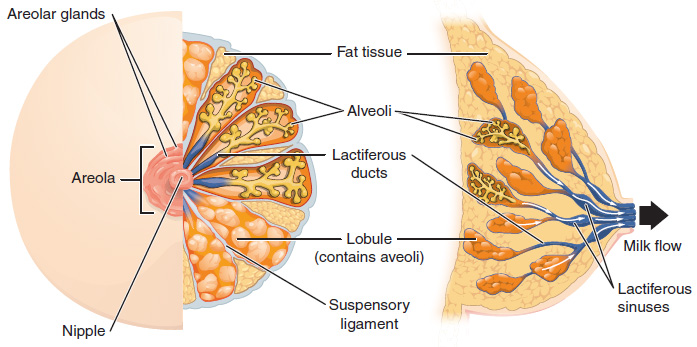
The Male Reproductive System
The Penis
The penis is flaccid for non-sexual actions, such as urination, and turgid and erect during sexual arousal. The shaft of the penis surrounds the urethra (Figure 84.5). Three colum-like chambers of erectile tissue span the length of the shaft. Each of the two larger lateral chambers of tissue is called a corpus cavernosum (plural = corpora cavernosa). Together, these make up the bulk of the penis. The corpus spongiosum, a raised ridge on the erect penis, is a smaller chamber that surrounds the spongy, or penile, urethra. The end of the penis, called the glans penis, has a high concentration of nerve endings, however not as dense and therefore not as sensitive as the glans clitoris (see Figure 84.5). The skin from the shaft extends down over the glans and forms a collar called the prepuce (or foreskin). The foreskin also contains a dense concentration of nerve endings, and both lubricates and protects the sensitive skin of the glans penis. A surgical procedure called circumcision, often performed for religious or social reasons, removes the prepuce, typically within days of birth. The skin of the glans of a circumcised penis converts from a mucous membrane to a cutaneous membrane, and the friction reducing function of the foreskin is lost.
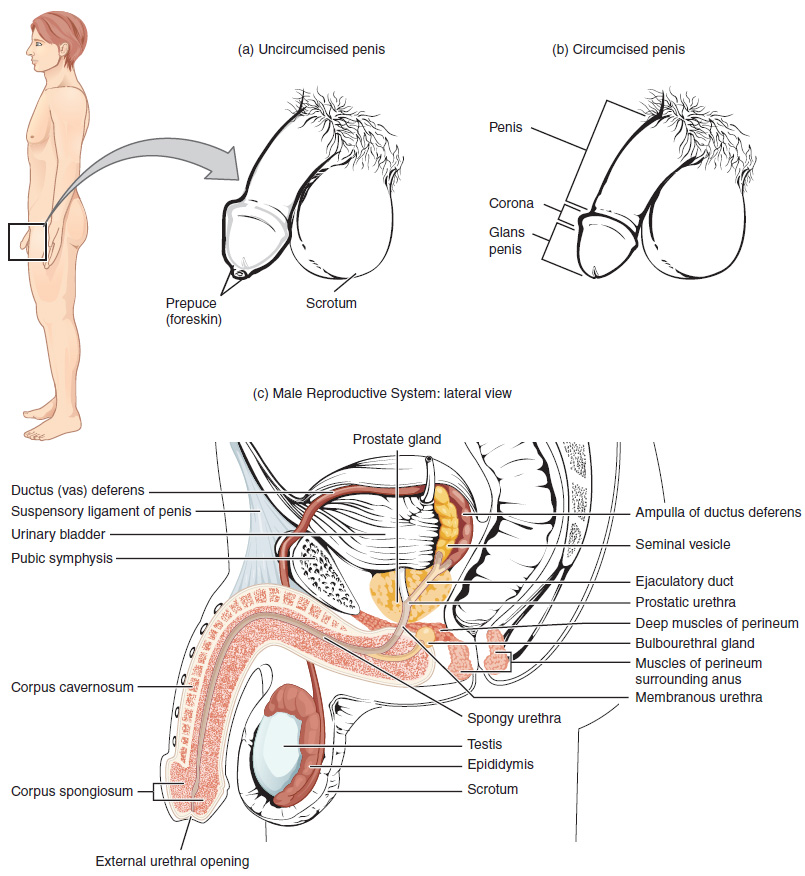
Testes
The testes (singular = testis) are the male gonads, which produce both sperm and androgens, such as testosterone, and are active throughout the sexual lifespan. The testes are spherical in shape, each approximately 4 to 5 cm in length and are housed within the scrotum (see Figure 84.7). They are surrounded by two distinct layers of protective connective tissue (Figure 84.6). The outer tunica vaginalis is a serous membrane that has both a parietal and a thin visceral layer (similar to the visceral and parietal serous membranes of the pericardium, peritoneum, and pleura). Beneath the tunica vaginalis is the tunica albuginea, a tough, white, dense connective tissue layer covering the testis itself. Not only does the tunica albuginea cover the outside of the testis, it also invaginates to form septa that divide the testis into 300 to 400 structures called lobules. Within the lobules, sperm develop in structures called seminiferous tubules. During the seventh month of the developmental period of a fetus secreting testosterone, each testis moves through the abdominal musculature to descend into the scrotal cavity. This is called the “descent of the testis.” Cryptorchidism is the clinical term used when one or both of the testes fail to descend into the scrotum prior to birth.
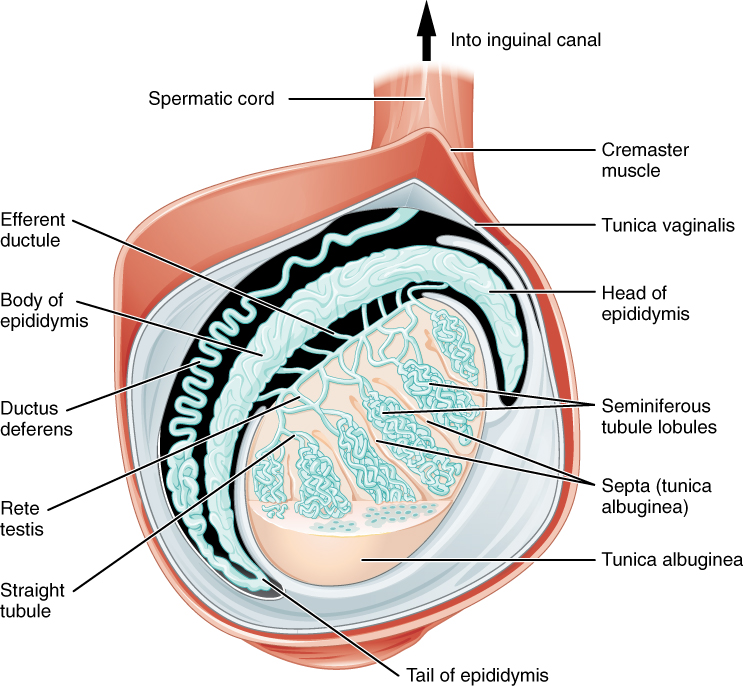
Seminiferous Tubules
The tightly coiled seminiferous tubules form the bulk of each testis. Within the tubules are developing sperm cells. From the lumens of the seminiferous tubules, sperm move into the straight tubules (or tubuli recti), and from there into a fine meshwork of tubules called the rete testes. Sperm leave the rete testes, and the testis itself, through the 15 to 20 efferent ductules that cross the tunica albuginea.
Inside the seminiferous tubules are six different cell types. These include supporting cells called sustentacular cells, as well as five types of developing sperm cells called germ cells. Germ cell development progresses from the basement membrane—at the perimeter of the tubule—toward the lumen.
Epididymis
From the lumen of the seminiferous tubules, the immotile sperm are surrounded by testicular fluid and moved to the epididymis (plural = epididymides), a coiled tube attached to the testis where newly formed sperm continue to mature (see Figure 84.6) Though the epididymis does not take up much room in its tightly coiled state, it would be approximately 6 m (20 feet) long if straightened. It takes an average of 12 days for sperm to move through the coils of the epididymis, with the shortest recorded transit time in humans being one day. Sperm enter the head of the epididymis and are moved along predominantly by the contraction of smooth muscles lining the epididymal tubes. As they are moved along the length of the epididymis, the sperm further mature and acquire the ability to move on their own. The more mature sperm are then stored in the tail of the epididymis (the final section) until ejaculation occurs.
Scrotum
The testes are located in a skin-covered, highly pigmented, muscular sack called the scrotum that extends from the body behind the penis (see Figure 84.5). This location is important in sperm production, which occurs within the testes, and proceeds more efficiently when the testes are kept 2 to 4°C below core body temperature.
The dartos muscle makes up the subcutaneous muscle layer of the scrotum (Figure 84.7). It continues internally to make up the scrotal septum, a wall that divides the scrotum into two compartments, each housing one testis. Descending from the internal oblique muscle of the abdominal wall are the two cremaster muscles, which cover each testis like a muscular net. By contracting simultaneously, the dartos and cremaster muscles can elevate the testes in cold weather (or water), moving the testes closer to the body and decreasing the surface area of the scrotum to retain heat. Alternatively, as the environmental temperature increases, the scrotum relaxes, moving the testes farther from the body core and increasing scrotal surface area, which promotes heat loss. Externally, the scrotum has a raised medial thickening on the surface called the raphae.
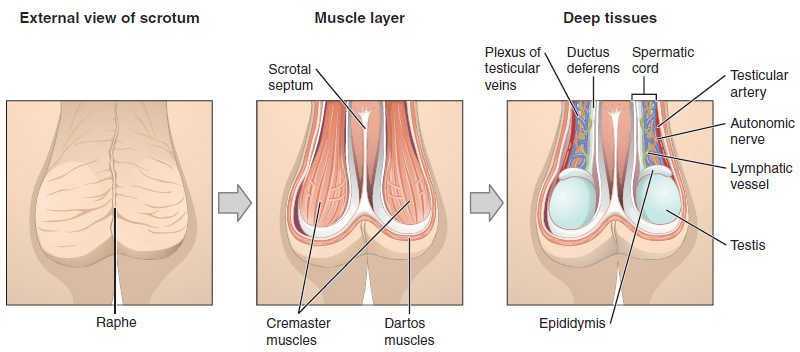
Duct System
During ejaculation, sperm exit the tail of the epididymis and are pushed by smooth muscle contraction to the ductus deferens (also called the vas deferens). The ductus deferens is a thick, muscular tube that is bundled together inside the scrotum with connective tissue, blood vessels, and nerves into a structure called the spermatic cord (see Figure 84.5 and Figure 84.7). Because the ductus deferens is physically accessible within the scrotum, surgical sterilization to interrupt ejaculation of sperm can be performed by cutting and sealing a small section of the ductus (vas) deferens. This procedure is called a vasectomy, and it is an effective form of birth control. Although it may be possible to reverse a vasectomy, clinicians consider the procedure permanent.
Each ductus deferens extends superiorly into the abdominal cavity through the inguinal canal in the abdominal wall. From here, the ductus deferens continues to the pelvic cavity, ending posterior to the bladder where it dilates in a region called the ampulla (meaning “flask”).
Sperm make up only 5 percent of the final volume of semen, the thick, milky fluid that is ejaculated. The bulk of semen is produced by three critical accessory glands of the sexual system: the seminal vesicles, the prostate, and the bulbourethral glands.
Seminal Vesicles
As sperm pass through the ampulla of the ductus deferens at ejaculation, they mix with fluid from the associated seminal vesicle (see Figure 84.5). The paired seminal vesicles are glands that contribute approximately 60 percent of the semen volume. Seminal vesicle fluid contains large amounts of fructose, which is used by the sperm mitochondria to generate ATP to allow movement.
The fluid, now containing both sperm and seminal vesicle secretions, next moves into the associated ejaculatory duct, a short structure formed from the ampulla of the ductus deferens and the duct of the seminal vesicle. The paired ejaculatory ducts transport the seminal fluid into the next structure, the prostate gland.
Prostate Gland
As shown in Figure 84.5, the centrally located prostate gland sits anterior to the rectum at the base of the bladder surrounding the prostatic urethra (the portion of the urethra that runs within the prostate). About the size of a walnut, the prostate is formed of both muscular and glandular tissues. It excretes an alkaline, milky fluid to the passing seminal fluid, now called semen.
Bulbourethral Glands
The final addition to semen is made by two bulbourethral glands (or Cowper’s glands) that release a thick fluid that lubricates the urethra, and helps to neutralize urine residues from the penile urethra. The fluid from these glands is released after the male becomes sexually aroused, and shortly before the release of the semen. It is referred to as pre-ejaculate.
Male and Female Homologues
Many structures in the male and female reproductive systems are homologous, meaning they arise from the same embryonic tissues and share similar functions despite their differences in form (Table 84.1). Understanding these homologues helps illustrate the common developmental pathways that underlie the reproductive systems in both sexes.
Ovaries and Testes
The ovaries in females and the testes in males are homologous structures. Both are gonads, responsible for producing gametes (oocytes in females and sperm in males) and sex hormones (estrogens and progesterone in females, and testosterone in males).
Clitoris and Penis
The clitoris in females and the penis in males are derived from the same embryonic tissue. Both structures contain erectile tissue that becomes engorged with blood during sexual arousal. The glans clitoris and glans penis are particularly sensitive and contain a high density of nerve endings.
Labia Majora and Scrotum
The labia majora in females and the scrotum in males are homologous. Both are external structures that protect the internal reproductive organs. The labia majora are folds of skin that protect the vaginal opening, while the scrotum houses and protects the testes, maintaining an optimal temperature for sperm production.
| Female Structure | Male Homologue | Embryonic Origin & Function |
|---|---|---|
| Ovary | Testis | Gonad; gamete & sex hormone production |
| Clitoral glans & crura | Glans & corpora of penis | Erectile tissue for sexual arousal |
| Labia majora | Scrotum | Skin folds protecting internal gonads |
| Greater vestibular glands | Bulbourethral glands | Mucous secretion to lubricate vestibule/urethra |
| “Female prostate” (Skene’s) | Prostate gland | Glandular secretion around urethra |
Hormonal Regulation of Reproductive Processes
The regulation of reproductive processes in both males and females is controlled by a complex interplay of hormones originating from the hypothalamus, pituitary gland, and gonads.
Gonadotropin-Releasing Hormone (GnRH)
GnRH is produced by the hypothalamus and released in a pulsatile manner. It acts on the anterior pituitary gland to stimulate the release of two key gonadotropins: follicle-stimulating hormone (FSH) and luteinizing hormone (LH).
Follicle-Stimulating Hormone (FSH)
In females, FSH promotes the growth and maturation of ovarian follicles, which are structures that contain the developing oocytes (eggs). In males, FSH stimulates the Sertoli cells within the seminiferous tubules to support spermatogenesis (the production of sperm).
Luteinizing Hormone (LH)
In females, LH triggers ovulation, the release of a mature oocyte from the ovary. It also stimulates the formation of the corpus luteum, which produces progesterone necessary for maintaining the early stages of pregnancy. In males, LH acts on the Leydig cells in the testes to stimulate the production of testosterone, which is essential for the development of male secondary sexual characteristics and spermatogenesis.
Estrogens and Progesterone
In females, estrogens are primarily produced by the developing follicles and are crucial for the regulation of the menstrual cycle, the development of female secondary sexual characteristics, and the preparation of the endometrium for potential pregnancy. Progesterone is produced mainly by the corpus luteum after ovulation and is essential for maintaining the endometrium and supporting early pregnancy.
Testosterone
In males, testosterone is produced by the Leydig cells in the testes under the stimulation of LH. Testosterone is vital for the development of male secondary sexual characteristics, the maintenance of libido, and the promotion of spermatogenesis.
Inhibin
In both males and females, inhibin is produced by the gonads (Sertoli cells in males and granulosa cells in females) and acts to inhibit the release of FSH from the anterior pituitary, providing a feedback mechanism to regulate the production of gametes.
Adapted from Anatomy & Physiology by Lindsay M. Biga et al, shared under a Creative Commons Attribution-ShareAlike 4.0 International License, chapter 27.
the rounded mass of fatty tissue anterior to the pubic bones, which is covered with pubic hair following puberty
two large folds of pubic hair-covered skin running from the mons pubis to the anus
skin folds that are medial to the labia majora, running from the clitoris to the opening of the vagina
the region between the two labia minora
the female homologue of the male penis; the female erectile tissue
the group of glandular tissue surrounding the urethra that release female ejaculatory fluids, consisting of the periurethral gland, paraurethral gland, and lesser vestibular gland
two pea-sized alveolar glands located inferior and posterior to the bulbs of the vestibule that secrete mucous (lubricating fluid) into the vestibular area through ducts that open on either side of the vaginal orifice
the muscular canal leading to the uterus; the birth canal
the hollow, muscular organ located between the bladder and rectum; the location of fetal development and growth; the womb
the female gonads; responsible for the production of the ova and secretion of female sex hormones; the female homologue to the male testes
male sex organ through which ejaculatory fluid and urine are excreted
the male gonads, responsible for producing sperm and male sex hormones (androgens)
cells within the seminiferous tubules of the testes responsible for supporting developing sperm cells
the external muscular sac responsible for holding the testes, located posterior to the penis
a thick, muscular tube inside the scrotum responsible for sperm transportation; forms the spermatic cord with connective tissue, nerves, and blood vessels
paired glands located in the pelvis superior to the rectum and inferior to the bladder, responsible for producing 60 percent of the fluid that composes semen, markedly fructose
gland formed of both muscular and glandular tissue, responsible for secreting fluid that makes semen alkaline
glands responsible for secreting fluid (pre-ejaculate) that lubricates the male urethra and neutralizes urine

